
Adding spandex to denim was a genius idea. There may be no going back to the ol’ fashion itchy scratchy jeans after owning a pair of jeans with stretch. What can you not do in them?The only downside is they don’t always hold up like the 100% cotton twill weave denim. Is it the fiber or that we won’t take them off? Whatever the reason you’ve worn out a spot and if you love them, why not patch them and wear them a little longer?
The Set Up:
The rule of thumb for patching any garment is to match fabrics; patch silk with silk, wool with wool and a stretch fabric with a stretch fabric. So when patching stretch jeans you “should” make the patch from stretch denim. However, when the patch is going on a spot that receives a lot of wear, the knees, the seat, and the inner thighs, can we patch with a more durable, non-stretch denim? And how do we apply the patch to retain the stretch for the jeans?
To test what would work and not work I sewed on and fused on three patches cut from non-stretch denim. I used three different machine stitches and three different hand stitches. All of the patches were placed on the upper, inner thigh area of stretch jeans. The area was stretched after each set of stitches, and the fusing, to test if it would still stretch and also recover after being stretched.
The jeans I sewed the patches onto are made with 2-way stretch denim, stretching across the jeans. I did not try 4-way stretch jeans, jeans which stretch in all directions.I believe the results would be the same.
Making the Patch:
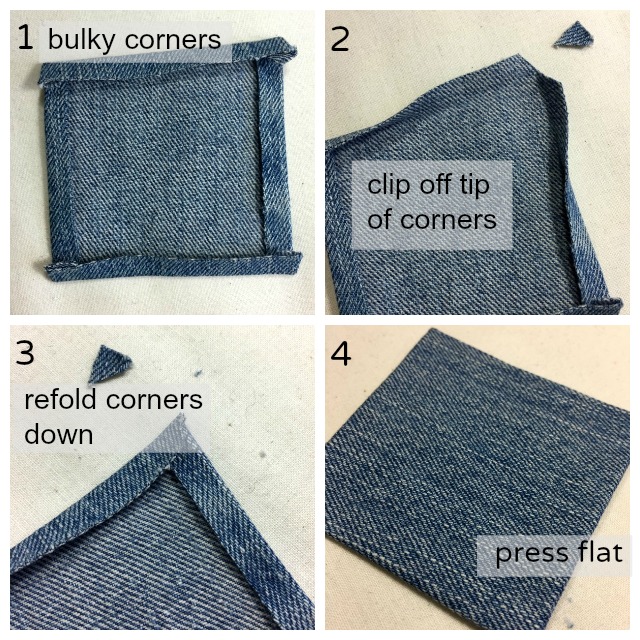
Patches start with cutting out a piece of fabric larger than the hole you need to cover. How you finish the raw edges of the patch can vary depending on what look you want or where the patch is going.
You could fold the raw edges under and press. When patching with denim and other thick fabrics the edges can appear bulky and the corners are bulky. Simply snip off the tips of the corners to reduce the bulk there. Pressing flat with a hot steam iron will help give a crisp edge to the patch.
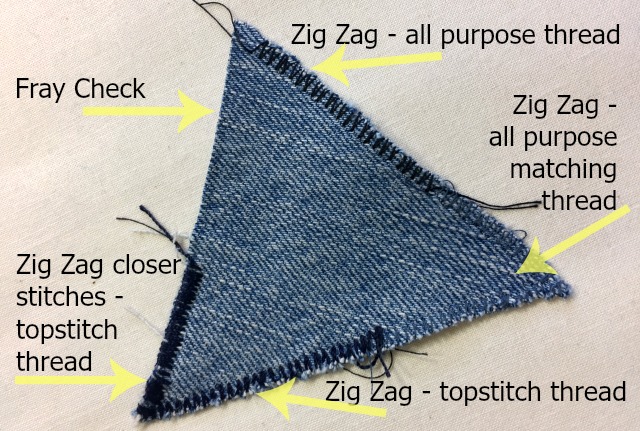
But there are other ways to finish the raw edges of a patch for less bulk or a different look.
With a sewing machine, you could sew a zig-zag stitch set at a short stitch length (about a 2) to encase the edge. With the zig-zag you could use an all-purpose thread in a contrasting color or, a matching thread to be more subtle (go a shade darker if you can’t match exactly).
For a bolder look try a thicker heavy duty or topstitching thread.
You could also make the stitch length shorter to really outline the patch.
Or you could use a sealant, such as Fray Check, on the raw edge to keep it from unraveling.
Sewing Non-Stretch Onto Stretch:
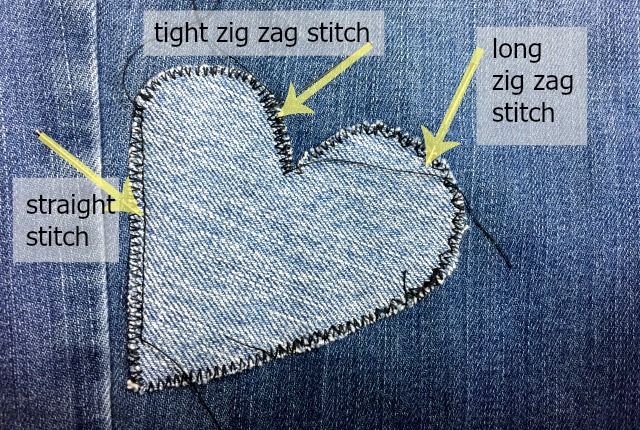
If your patch is going where a sewing machine can reach, use it. Just remember to use a universal or ball point needle and not a denim needle. You don’t want to cut the stretch fibers in the jeans and a denim or non-universal needle will do that.
The straight stitch, the basic stitch, is easy and fast but it didn’t let the jeans stretch.
The zig-zag stitch, set to the same stitch length I used to cast over the edges, about a 2, looked good. However, it didn’t let the jeans stretch either.
A narrower zig-zag stitch with a longer stitch length, about a 3, worked. The jeans were able to stretch and recover.
A narrow, long zig-zag stitch is the stitch to use with stretch fabrics.
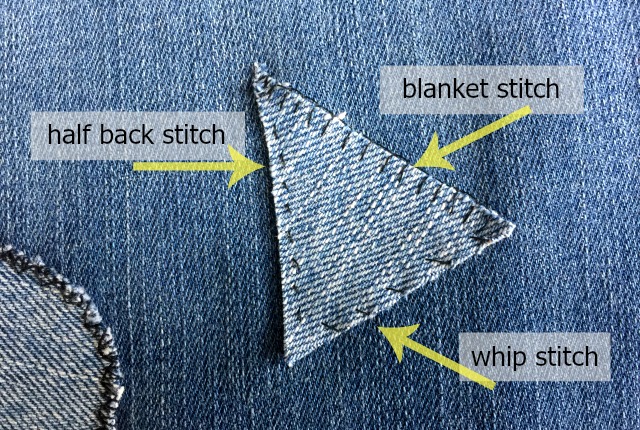
If you need to sew the patch on by hand you can use any needle but try to use the smallest size that is still strong enough to go through your denim. (See these tips for hand sewing)
The blanket stitch came to mind first since it sort of encases the edge of the patch. Perfect if you don’t have a sewing machine. However, it didn’t let the jeans stretch. It may be that my stitches were too close together to allow much stretch but I really think it’s the stitch. Besides this stitch takes some time, focus and a lot of thread. We can do better.
The half-back stitch is a great stitch for apparel sewing because it can hold up to a lot of stress and pressure. But it was too strong and didn’t let the jeans stretch at all.
The whip stitch is a simple up, over, down and back up motion. It’s the stitch you would probably do if you didn’t think about it. I spaced the stitches to resemble the long zig-zag stitch from the machine which I knew allowed the jeans to stretch.
The whip stitch was the winner; no contest. The jeans stretched and recovered and the patch stayed in place.
But Wait, Can We Just Iron the Patch On?
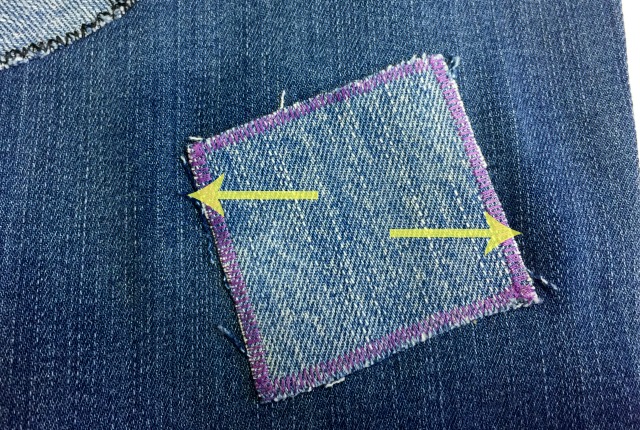
The final test was fusing a patch on with fusible bonding web. This is a webbing, which you cut to the size of the patch and place between the patch and what you are applying it to. A hot iron melts the webbing into glue, fusing the patch to the fabric.
Glued or fused patches on garments that are laundered have a tendency to eventually peel off the garment. Since jeans are washed frequently I wouldn’t think this is the best method to use. It is the fastest method though so I wanted to test it.
The patch stuck to the jeans and the jeans stretched but they did not recover. They did not go back into shape. Notice the puckers on the sides of the fused patch from being stretched.
Fusing or gluing a patch onto stretch denim might work somewhere below the knee on straight leg jeans or where your jeans are not stretched.
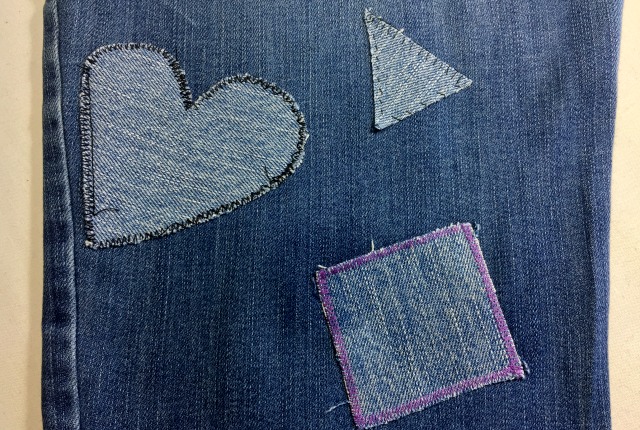
These are my results you may experience something different so if you can, do a test but I really wouldn’t recommend any glue or fusing method.
For mending non-stretch jeans you could use any of the stitches I tried or this fun method.
Mending your clothes is a good thing especially your favorite pieces. You can get pretty creative with mending visible holes; decorative patches, leather patches, added embroidery or beading.
You can really have fun with your mending if you know you’re retiring the garment from dressy occasions anyway. And why not do your mending with friends? Everyone’s got a mending pile. Invite your pals over for a mending party, productive social time – that’s a winner.

thank you, some good ideas tested, thanks for showing all the results. (September 2018)
Yes, It’s good to see all the options. Thank you.
I am reading your blog and i get the right information on this blog. Thanks a lot for this beauty Enjoying article with me. I appreciate it very much!
I’m glad you like the article and find it helpful. Thanks for reading
Hi! How can I glue a piece of fabric underneath my jeans please? What glue should I use?
When you want to put the patch under the hole try the method described here: http://www.thedailysew.com/2015/03/how-to-patch-a-hole-in-a-garment/ I would use a fusible bonding product like the one I used in that post but you maybe able to use any fabric glue. You just want to apply it evenly and not where it will seen 😉 If you can’t or don’t want to sew the patch in place after gluing it then perhaps avoid putting the patched garment in the dryer. The heat from the dryer can melt and/or loosen the glue making the patch eventually fall off. However, now that I say that, if it falls off you could replace it, or by the time it falls off the garment may be at the end of its life anyway.